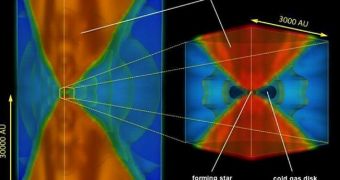According to the conclusions of a new computer simulation carried out by researchers at the NASA Jet Propulsion Laboratory, in Pasadena, California, it would appear that the earliest stars in the Universe were not as massive as previous studies suggested.
Until now, astronomers believed that the first stars to form after the Big Bang were incredibly large, primarily due to the fact that they had access to vast reserves of hydrogen gas. This is the main constituent that goes into making new stellar objects.
During the new study, experts simulated the conditions of the early Universe, and then planted the seeds of new stars within the model. The team then watched as the stars grew, and analyzed their maximum size and weight.
Even after giving the forming stars millions of years to develop, the group was still surprised at how small the objects became. They were expecting to see massive stars, of the type that die in supernova events, and whose cores form neutron stars and black holes.
Previous theories had suggested that the first stars were several hundreds of times more massive than the Sun is today, but this simulation suggests that the objects were actually just tens of times larger.
“The first stars were definitely massive, but not to the extreme we thought before,” Takashi Hosokawa explains. The expert holds an appointment as an astronomer at JPL and is also the lead author of a new paper detailing the findings.
The work is detailed in the November 11 issue of the top journal Science. “Our simulations reveal that the growth of these stars is stunted earlier than expected, resulting in smaller final sizes,” he says.
JPL astronomer, and study coauthor, Harold Yorke, says that “this is definitely going to surprise some folks. It was standard knowledge until now that the first stars had to be extremely massive.”
The mechanism that prevented the formation of massive stars in the early Universe is heavily reliant on temperature. The team found that helium and hydrogen gas around a protostar could experience temperatures of about 50,000 Kelvin (90,000 degrees Fahrenheit, 49,727 degrees Celsius).
These conditions were enough to trigger the expansion of surrounding gas clouds, removing them from around the forming star, and reducing the mass it could accrete in order to grow. In effect, its own growth led to limiting its growth.
“I am sure there are more surprises in store for us regarding this exciting period of the Universe. NASA's upcoming James Webb Space Telescope will be a valuable tool to observe this epoch of early star and galaxy formation,” Yorke concludes.

 14 DAY TRIAL //
14 DAY TRIAL //